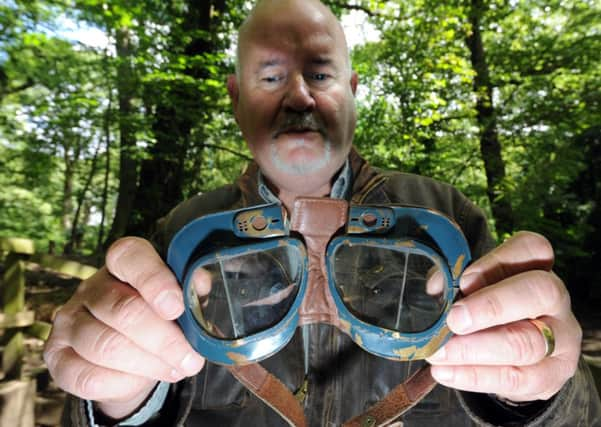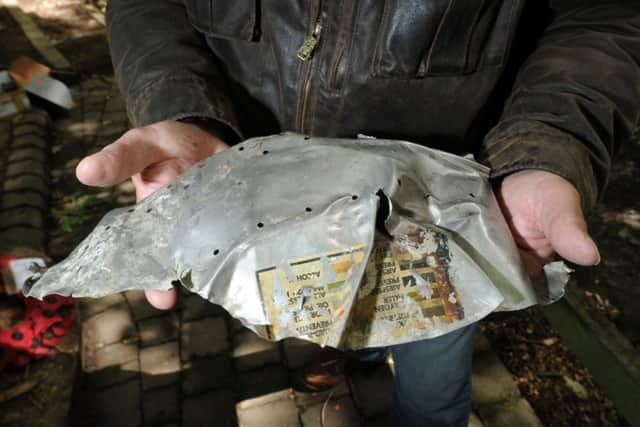Journey into the past


Towards teatime one winter afternoon in 1944, a Sheffield industrialist’s wife was feeding the hens in her garden when she heard the whirr of aircraft engines overhead. She glanced up and saw an American bomber flying unusually low. Later that evening she told a newspaper reporter what happened next:
“I waved to it as I always do when I see a plane pass over. Then it came lower and gave what I thought must be a victory roll, and I was pleased to think the boys aboard had seen me wave and were answering. Suddenly the bomber made three terrific spins and plunged earthwards. There was a terrible crash and a sudden uprush of flame.”
Advertisement
Hide AdAdvertisement
Hide AdThe plane, a B17 “Flying Fortress” bomber, ploughed into a hillside in Endcliffe Park, a few hundred yards from where Mrs ABH Clerke – her Christian name wasn’t reported – was standing. It had flown across the city, with flames reportedly trailing back from its wings, and was so low over the rooftops that other eye-witnesses said they could make out the faces of the crew. All 10 members of that crew were killed as the plane hit the ground, uprooting trees. It broke up and burst into flames.


The background to the crash, an amazing story of Second World War heroism, has passed so vividly into local legend that Sheffield Council is marking its 70th anniversary by erecting a sign to guide visitors to the memorial at its site.The memorial is a rough-hewn block of stone at the foot of a shady, rather lonely, hill across a stream from the park’s cafe and children’s playground. Surrounded by 10 specially planted oak trees, it was unveiled in 1969 and carries two brass plaques honouring the crew.
They were being brought back from a European mission by the stricken bomber, which they had named Mi-Amigo (my friend). According to the traditional version of events, the pilot steered the plane away from dense housing and children playing in the park. But is this true?
Few people know as much about what happened on that February afternoon as David Harvey, who was so intrigued when he first heard about the crash that he spent four years researching a book about it. He traced relatives of most of the airmen and has built up a small collection of relics found on the site.
Advertisement
Hide AdAdvertisement
Hide AdDavid, who works in the oil pipeline industry, got interested in the American Eighth Air Force 25 years ago, while living at Dronfield, just outside Sheffield. He had seen Memphis Belle, the film about the last mission of a B17 bomber.
“It really got under my skin,” he says when we meet at the memorial, which has four poppy wreathes propped against it, left here since the annual commemoration service held on the Sunday nearest the crash anniversary.
David read everything he could find about “the Mighty Eighth” and came across a book listing memorials to airmen who died on missions. “It mentioned a memorial stone in Endcliffe Park,” he says.
“I’d been to the park many, many times with my children, but had never seen it. So I went down the next weekend with my son and, after some effort, we found it. The two plaques on it had little detail except the names of the crew and the date of the crash. I knew then that there was a book to be written about it.”
Advertisement
Hide AdAdvertisement
Hide AdHe set about delving into the story, traced eye-witness accounts, and wrote countless letters (“This was in pre-internet days; it would be so much easier now”).
He found group photographs of the crew and included two of them in his book, Mi Amigo: The Story of Sheffield’s Flying Fortress. They show clean-cut young men, mostly in their early twenties, posing in front of bombers. They wear leather flying jackets; most grin confidently, a few look slightly bashful.
They were a cross-section of everyday America – a shoe factory warehouseman from Missouri, a farmer from Idaho, a high school graduate from Oklahoma who played guitar in a band at school-hall hops. One had got married just a day before he left for England.
They were stationed at Chelveston in Northamptonshire before what was to prove their final mission, part of “Big Week”, a campaign which dispatched parties of American bombers to try to eliminate Luftwaffe factories.
Advertisement
Hide AdAdvertisement
Hide AdThe target on February 22 was an airfield at Aalborg in Nazi-occupied Denmark, but heavy cloud stopped the bombers locating it and they turned back for home without dropping their bombs. Swarms of German fighters attacked them and Mi-Amigo was singled out. The crew fought back with machine guns, and jettisoned their bombs over the North Sea, but the plane’s engines were seriously damaged.
David Harvey, now living in Glapwell in North Derbyshire, believes its radio and navigational instruments may also have been affected, which could explain why its four-hour flight back to England brought it so far north.
The assumption is that the pilot was looking for a suitable area of flat land in hilly Sheffield, but his engines were dying and his fuel was running out.
Immediately after the crash, rescuers rushed to the burning wreckage. A 12-year- old boy, Arthur Needham, found one of the crew still alive and trying desperately to get out of the fuselage. He was trapped by the legs and cried out: “Can you save me kid?” Arthur grasped his hand but was beaten back by the heat.
Advertisement
Hide AdAdvertisement
Hide AdIt took fireman an hour to extinguish the flames. Soldiers cordoned off the site to keep away onlookers. All this time, as David points out, no-one knew whether the plane’s bombs were still on board.
Researching his book, he discovered common threads of memory. “People from all over Sheffield saw it circling in the sky for an hour as though looking for somewhere to land, but at the end it ran out of fuel,” he says. “It was lucky for Sheffield that it was over the park and not over factories and houses.”
He also found conflicting accounts of exactly how it came down. “People said they’d seen the crash, but they clearly hadn’t,” he says. “They’d told their stories so often that they couldn’t backtrack. The story had got romanticised over the years.”
Some evidence suggests, for instance, that children may not have been playing in the park at the time, undermining one of the story’s most potent aspects: the pilot’s heroic efforts to avoid them.
Advertisement
Hide AdAdvertisement
Hide Ad“Some didn’t like the fact that I was questioning the legend that had grown up over the years. But what I found didn’t take away anything from those 10 guys. It actually increased my admiration for them.”
He opens a cardboard box he has brought with him. Inside is a battered foot-long fragment of the plane’s aluminium fuselage – the metal surprising thin – and a radio box from its cabin. They were found at the site when the public was allowed near it again and the finders kept them for years before giving them to David.
“People flocked in and tried to find souvenirs, and someone found these glinting in the stream...” He unpacks the most poignant relic of all, a pair of padded leather flying goggles. “When you think what the last guy to wear them had seen, it’s very moving.”
Most moving perhaps was David’s quest to find out about 2nd Lt Lyle J Curtis, the Mi-Amigo’s co-pilot, who came from a small community near the town of Idaho Falls. “I was having real difficulty finding anyone who knew about him, so I contacted the Mayor of Idaho Falls and he sent out people who found Lyle’s widow, Erma,” he says.
Advertisement
Hide AdAdvertisement
Hide AdLyle and Erma had married six weeks before he was posted to England. While stationed here he learned she was pregnant, but he never saw his daughter, Barbara; he died four months before she was born.
Erma and Barbara visited England 50 years after the crash and David drove them to sites associated with Lyle. “It was very emotional,” he says. “Barbara said her father had always been a photograph on the dresser.”
They visited the Imperial War Museum at Duxford in Cambridgeshire, which houses the only airworthy Flying Fortress in Europe. “As we were looking at it,” says David, “Erma said that the last time she’d seen a Flying Fortress was when she waved her husband off to England.”
• Mi Amigo: The Story of Sheffield’s Flying Fortress is out-of-print but copies are available online.
Courage Above the Clouds by Paul Allonby is a well-researched and evocative account of the Mi-Amigo crash. Available on Amazon Kindle.